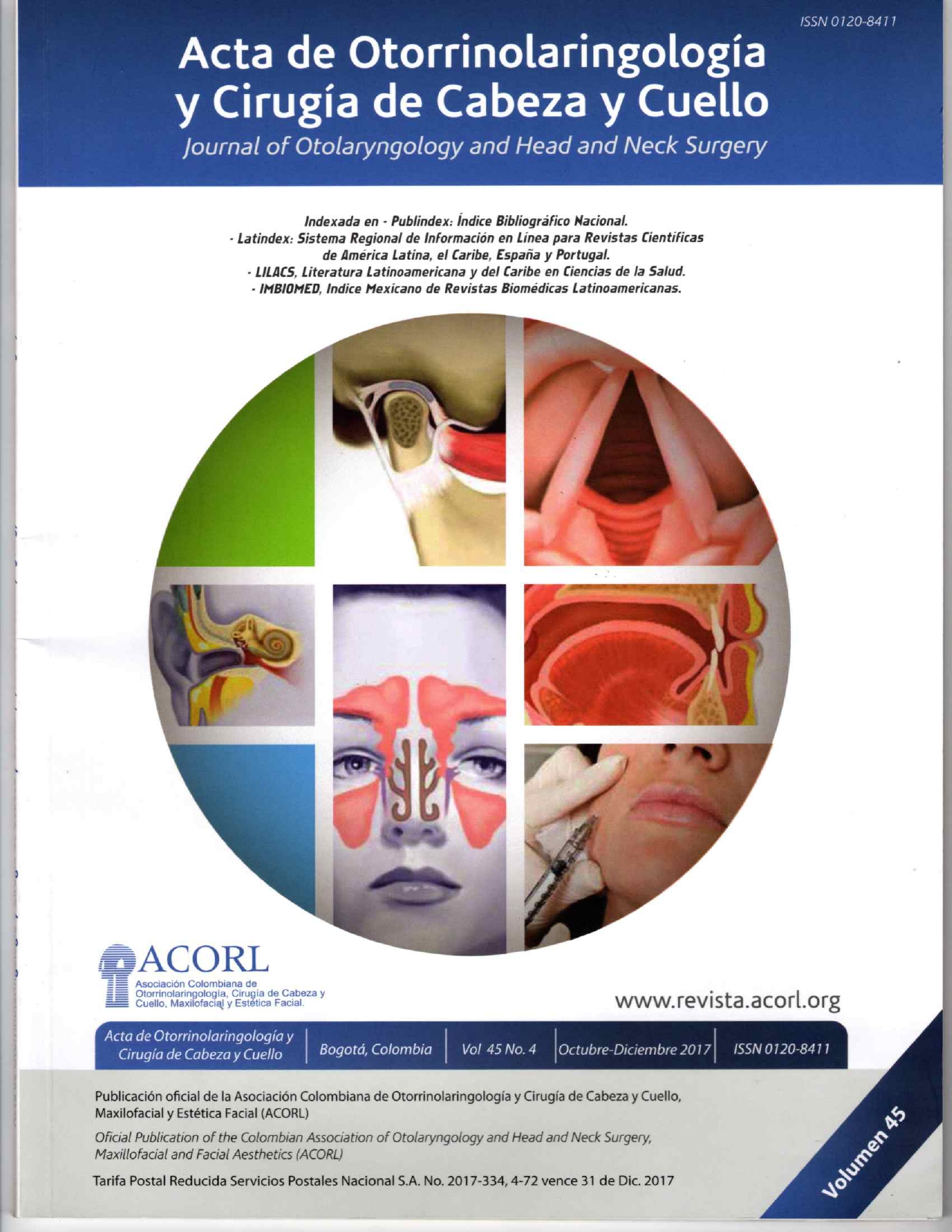Transporte óseo alveolar intraoral en pacientes con hendiduras alveolares: serie de casos Intraoral alveolar bone transportation in alveolar cleft patients: case series
Contenido principal del artículo
Resumen
Introducción: El tratamiento de la hendidura alveolar, del paciente fisurado, permite un adecuado crecimiento facial. Los injertos óseos han sido el tratamiento ideal. Sin embargo la técnica de distracción osteogénica mediante transporte óseo alveolar intraoral ha demostrado ser muy predecible. Objetivo: Describir los resultados del cierre de la Hendidura alveolar, con la técnica de transporte óseo alveolar intraoral bifocal y trifocal en pacientes labio fisurados. Diseño: Estudio retrospectivo de serie de casos. Materiales y métodos: Fueron tratados 4 pacientes con hendidura alveolar unilateral, manejados con la técnica de transporte óseo alveolar intraoral bifocal y trifocal en el año 2008 al 2009, con un seguimiento hasta el año 2014. Todos los pacientes fueron tratados con un aparato Hyrax® (Dentaurum, Alemania) modificado. Resultados: El promedio de distancia del transporte óseo requerido fue de 9,75mm (rango de 15 mm a 9 mm). Se colocaron 5 implantes dentales rehabilitados con prótesis dental fija. Conclusión: El estudio de los casos clínicos demuestra una predictibilidad
elevada así como un rango de éxito alto, en los individuos tratados con
esta técnica. Por tal motivo el transporte óseo alveolar intraoral es una alternativa eficaz para el tratamiento de hendiduras alveolares extensas.
Introduction: The management of alveolar cleft patients, allows an adequate facial growth in cleft lip and palate patients. Bone grafts have been the gold standard treatment. However, the technique of osteogenic distraction by intraoral alveolar bone transportation has proven to be highly predictable. Objective: To describe the results of alveolar cleft management with the intraoral bifocal and trifocal alveolar bone transportation technique in cleft palate patients. Design of study: Retrospective case series study. Materials and methods: 4 patients with unilateral alveolar cleft were treated with the bifocal and trifocal intraoral alveolar bone transportation technique from 2008 to 2009. The cases were followed up until 2014. All patients were treated with a modified Hyrax® (Dentaurum, Germany) device. Results: The average distance of bone transportation required was 9.75mm (range from 15mm to 9mm). 5 dental implants with fixed dental prosthesis were placed. Conclusion: Clinical cases study demonstrated a high predictability, as well as a high success rate
in individuals treated with this technique. Therefore, intraoral alveolar bone transportation is an effective alternative for the management of extensive alveolar clefts.
Detalles del artículo
Sección

Esta obra está bajo una licencia internacional Creative Commons Atribución-CompartirIgual 4.0.
Este artículo es publicado por la Revista Acta de Otorrinolaringología & Cirugía de Cabeza y Cuello.
Este es un artículo de acceso abierto, distribuido bajo los términos de la LicenciaCreativeCommons Atribución-CompartirIgual 4.0 Internacional.( http://creativecommons.org/licenses/by-sa/4.0/), que permite el uso no comercial, distribución y reproducción en cualquier medio, siempre que la obra original sea debidamente citada.
eISSN: 2539-0856
ISSN: 0120-8411
Cómo citar
Referencias
1. Cohen M, Polley JW, Figeroa AA. Secondary (Intermediate) alveolar bone grafting. Clin Plast Surg. 1993;20(8):691–705.
Georgiade NC, Pickrell KL, Quinn GW. Varying concepts in bone grafting of alveolar palatal defects. Cleft Palate J. 1964;1(1):43-47
Troxell JB, Fonseca RJ, Osbon DB. A retrospective study of alveolar bone grafting. J Oral Maxillofac Surg. 1982;40(11):721-5.
Eppley BL. Alveolar Cleft Bone Grafting (part I): Primary Bone Grafting. J Oral Maxillofacial Surg.1996;54(1):74-82.
Sindet-Pedersen S, Enemark H. Comparative study of secondary and late secondary bone grafting in patients with residual cleft defects. Int J Oral Surg 1985;14(5):389-398.
McCarthy JG, Schreiber J, Karp N, Thorne CH, Grayson BH. Lengthening the human mandible by gradual distraction. Plast Reconstr Surg. 1992;89(1):1-8.
Guerrero CA. Intraoral bone transport in clefting. Oral Maxillofacial Surg Clin North Am. 2002;14(2):509–23.
Liou EJ, Chen PK, Huang CS, Chen YR. Interdental distraction osteogenesis and rapid orthodontic tooth movement: a novel approach to approximate a wide alveolar cleft or bony defect. Plast Reconstr Surg. 2000;105(4):1262–72.
Guerrero C, Bell W, Gonzalez M, Meza L. Intraoral distraction osteogenesis (bone transport). En: Fonseca R, editor. Oral and maxillofacial surgery. 5a Ed. Philadelphia: WB Saunders; 2000. p. 343–402.
Costantino PD, Shybut G, Friedman CD, Pelzer HJ, Masini M, Shindo ML, et al. Segmental mandibular regeneration by distraction osteogenesis: an experimental study. Arch Otolaryngol Head Neck Surg.1990;116(5):535-45.
Ilizarov GA. The Tension-Stress Effect on the Genesis and Growth of Tissues: Part I. The Influence of Stability of Fixation and Soft-Tissue Preservation. Clin Orthop Relat Res. 1989;238(1):249-81,
Ilizarov GA. The Tension-Stress Effect on the Genesis and Growth of Tissues: Part II. The Influence of the Rate and Frequency of Distraction. Clin Orthop Relat Res. 1989;239(2):263-285.
Pereira MA, Luiz de Freitas PH, da Rosa TF, Xavier CB. Understanding Distraction Osteogenesis on the Maxillofacial Complex: A Literature Review. J Oral Maxillofac Surg. 2007;65(12):2518-2523.
Block MS, Brister GD. Use of distraction osteogenesis for maxillary advancement: preliminary results. J Oral Maxillofac Surg. 1994;52(3):282-6.
Vega O, Pérez D, Páramo V, Falcón J. A new device for alveolar bone transportation. Craniomaxillofac Trauma Reconstr [Internet] Jun 2011 [citado 2017 Mayo 8]; 4(2):91-106. Disponible en: https://www.ncbi.nlm.nih.gov/pmc/articles/PMC3193299/ doi: 10.1055/s-0031-1279669.
Guerrero CA, Bell WH, Meza LS. Intraoral distraction osteogenesis: maxillary and. mandibular lengthening. Atlas Oral Maxillofac Surg Clin North Am. 1999;7(1):111-51.
Hegab AF. Closure of the Alveolar Cleft by Bone Segment Transport Using an Intraoral Tooth-Borne Custom-Made Distraction Device. J Oral Maxillofac Surg. 2012;70(5):337-348.
Yen SL, Gross J, Wang P, Yamashita DD. Closure of a large alveolar cleft by bony transport of a posterior segment using orthodontic archwires attached to bone: Report of a case. J Oral Maxillofac Surg. 2001;59(6):688-91.
Hoffmeister B, Wangerin K. Callus distraction technique by an intraoral approach: the floating bone concept. Int J Oral Maxillofac Surg. 1997;26(1):76-81.





